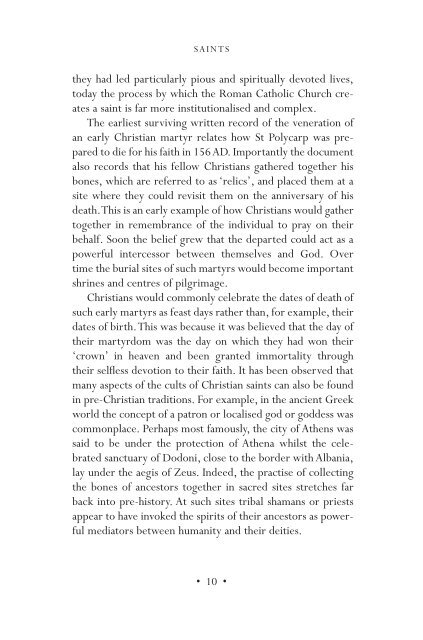02Knights Templar - Julian Emperor
02Knights Templar - Julian Emperor
02Knights Templar - Julian Emperor
You also want an ePaper? Increase the reach of your titles
YUMPU automatically turns print PDFs into web optimized ePapers that Google loves.
SAINTS<br />
they had led particularly pious and spiritually devoted lives,<br />
today the process by which the Roman Catholic Church creates<br />
a saint is far more institutionalised and complex.<br />
The earliest surviving written record of the veneration of<br />
an early Christian martyr relates how St Polycarp was prepared<br />
to die for his faith in 156AD. Importantly the document<br />
also records that his fellow Christians gathered together his<br />
bones, which are referred to as ‘relics’, and placed them at a<br />
site where they could revisit them on the anniversary of his<br />
death.This is an early example of how Christians would gather<br />
together in remembrance of the individual to pray on their<br />
behalf. Soon the belief grew that the departed could act as a<br />
powerful intercessor between themselves and God. Over<br />
time the burial sites of such martyrs would become important<br />
shrines and centres of pilgrimage.<br />
Christians would commonly celebrate the dates of death of<br />
such early martyrs as feast days rather than, for example, their<br />
dates of birth.This was because it was believed that the day of<br />
their martyrdom was the day on which they had won their<br />
‘crown’ in heaven and been granted immortality through<br />
their selfless devotion to their faith. It has been observed that<br />
many aspects of the cults of Christian saints can also be found<br />
in pre-Christian traditions. For example, in the ancient Greek<br />
world the concept of a patron or localised god or goddess was<br />
commonplace. Perhaps most famously, the city of Athens was<br />
said to be under the protection of Athena whilst the celebrated<br />
sanctuary of Dodoni, close to the border with Albania,<br />
lay under the aegis of Zeus. Indeed, the practise of collecting<br />
the bones of ancestors together in sacred sites stretches far<br />
back into pre-history. At such sites tribal shamans or priests<br />
appear to have invoked the spirits of their ancestors as powerful<br />
mediators between humanity and their deities.<br />
•10•













